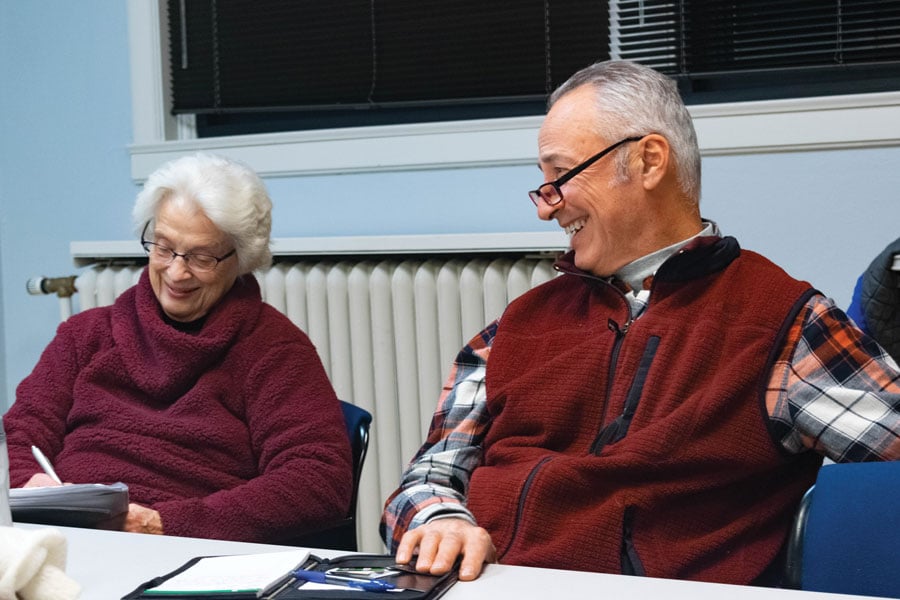Evanston organizations provide sustainable modes of transportation
Max Lubbers/The Daily Northwestern
Sue Carlson and Brian Becharas listen during a Citizens Greener Evanston Transportation Task Force meeting on Nov. 11. Members talked about sustainable transportation issues, including how to address snow removal concerns for pedestrians.
November 14, 2019
At the corner of some streets in Evanston, there is a special kind of “bus stop.” Here, no vehicle will come pick up students. Instead, a group will walk together to school under the guidance of a designated adult, calling themselves a “walking school bus.”
This is just one environmentally friendly form of transportation that Vickie Jacobsen, a founding member of Go Evanston, employs in her own family’s life. She said Go Evanston advocates for sustainable, safe modes of transportation for Evanston residents. The group is a sub-organization of Citizens’ Greener Evanston, a nonprofit organization focused on sustainability. CGE also has a Transportation Task Force who meet to find local transportation issues and come up with solutions, according to its chair, Brian Becharas.
Though they mainly work separately, they share a goal for environmental transportation advocacy.
According to the City of Evanston’s 2017 Emissions Inventory, transportation accounts for 17 percent of the community’s total net emissions of greenhouse gases.
“The big picture is less pollution,” said Rick Martin, a task force member. “Automobiles provide a lot of pollution, so why don’t we have people ride them less?”
To do that, the task force has to incentivize other forms of transportation.
”Green transportation is all about reducing vehicle miles traveled in the community and encouraging alternative modes,” Becharas said.
Becharas said task force members observe different transportation issues in the community and alert the city about dangerous situations or impediments to travel. Every second Monday, they meet at 7:30 pm in Evanston Civic Center Room 2403. At the Nov. 11 meeting, part of the conversation centered on how to address winter conditions.
Members of the task force decided to write an email to the city about enforcing the regulation that requires homeowners and businesses to shovel within 24 hours of a snowfall, according to the city website. Meanwhile, Jacobsen said Go Evanston encourages its members to call the 311 to make a snow removal request.
In general, Jacobsen said Go Evanston takes a three-pronged approach: education, engagement and encouragement. She said the organization educates the public, city officials and city staff; it also focuses on engaging members to become active in the political system and working with different organizations. Finally, “encouragement” presents different modes of transportation in a fun way.
“The encouragement piece is trying to help educate and bring events and learn where the best biking routes are, so that families with children and older people and all the people who need a little more encouragement to get out on a bicycle or try riding the bus have the info they need, and feel more comfortable doing it,” Jacobsen said.
Part of that work can also mean explaining the impact of transportation policy. Earlier this year, for example, Jacobsen said many residents were upset by the raise of parking rates.
According to a press release on Feb. 28, 2019, new prices took effect March 1. The changes included that parking at a two-hour meter or pay station increased from $1 to $1.50. The proposed 2020-2021 budget could also increase the price for on-street parking from $1.50 to $2.00. However, she explained that making parking free or cheap causes “induced demand.”
“If we made the parking very cheap or free, people would not factor cost into their decision to drive to the downtown area, so you end up generating more traffic by attracting more people,” she said.
Jacobsen said parking prices that are too low cause a downtown area to be “overrun with traffic,” which causes pollution and creates an environment that is less pleasant to be in.
She said working on transportation issues is critical to combating climate change, but taking alternate modes of transportation also helps form a community.
“You engage with the community in a different way when you’re on foot, on bicycle or on transit. Rather than like cars, where you’re in your own little zone, you end up interacting with the community in a more friendly, more vulnerable way,” Jacobsen said. “And I think that’s a real benefit that you can see.”
Email: mlubbers@u.northwestern.edu


